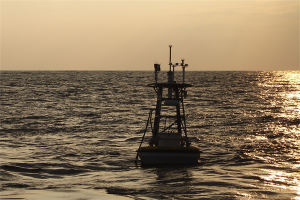Variability and trends in surface seawater pCO2 and CO2 flux in the Pacific Ocean
 Kurishio Extension Observatory mooring. (Credit: NOAA)
Kurishio Extension Observatory mooring. (Credit: NOAA)
High-resolution moored time series of sea-air CO2 flux reveal seasonal to decadal variability influences detection of anthropogenic trends, according to CPO-supported paper published in Geophysical Research Letther. This study on partial pressure of carbon dioxide (pCO2) and CO2 in the Pacific Ocean states that this natural variability tends to be underestimated by models and climatologies.
Researchers calculated CO2 flux from high-frequency mooring ΔpCO2 and wind speed observations on four ocean reference moorings in different biomes of the Pacific Ocean over a 10-year period to examine variability and its drivers over a range of time scales at the Kuroshio Extension Observatory (KEO), Ocean Station Papa, WHOI Hawaii Ocean Timeseries Station (WHOTS), and Stratus.
Anomalous 2013-2015 North Pacific warming caused the WHOTS location to be a net CO2 source for the first time in the observational record.
This study was supported by CPO’s Ocean Observing and Monitoring Division.
Abstract:
Variability and change in the ocean sink of anthropogenic carbon dioxide (CO2) have implications for future climate and ocean acidification. Measurements of surface seawater CO2 partial pressure (pCO2) and wind speed from moored platforms are used to calculate high-resolution CO2 flux time series. Here we use the moored CO2 fluxes to examine variability and its drivers over a range of time scales at four locations in the Pacific Ocean. There are significant surface seawater pCO2, salinity, and wind speed trends in the North Pacific subtropical gyre, especially during winter and spring, which reduce CO2 uptake over the 10 year record of this study. Starting in late 2013, elevated seawater pCO2 values driven by warm anomalies cause this region to be a net annual CO2 source for the first time in the observational record, demonstrating how climate forcing can influence the timing of an ocean region shift from CO2 sink to source.